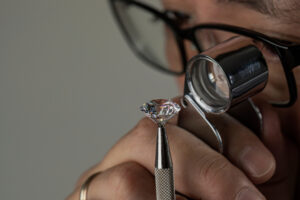
The allure of diamonds has captivated humanity for centuries, and while traditionally these precious gems have been sourced from deep within the Earth, a new chapter in their story is unfolding in laboratories. Lab-grown diamonds, also known as synthetic or cultured diamonds, are gaining prominence as a sustainable and ethical alternative to mined diamonds. In this exploration, we embark on the fascinating journey of lab-grown diamonds, tracing their path from the controlled environments of laboratories to the hearts of those who appreciate their beauty and responsible origins.
1. The Genesis: Setting the Stage for Growth
The journey of a lab-grown diamond begins with a tiny seed crystal, often a fragment of a natural diamond. This seed crystal serves as the foundation for the diamond’s growth. Unlike their natural counterparts, lab-grown diamonds are not formed through geological processes deep within the Earth. Instead, they are cultivated using advanced technological methods that mimic the conditions necessary for diamond formation.
2. The Art of Creation: High-Pressure, High-Temperature (HPHT) Method
One of the primary methods for growing lab-grown diamonds is the High-Pressure, High-Temperature (HPHT) process. In this method, the seed crystal is subjected to extreme conditions resembling those found deep within the Earth. High pressure, typically around 725,000 pounds per square inch, and high temperature, exceeding 2,000 degrees Celsius, stimulate the growth of the diamond. The carbon atoms arrange themselves into the crystal lattice structure that characterizes diamonds, resulting in the gradual formation of a lab-grown diamond.
3. A Dance of Atoms: Chemical Vapor Deposition (CVD) Method
Another method employed in the creation of lab-grown diamonds is Chemical Vapor Deposition (CVD). This process involves creating a gas mixture that is rich in carbon. The gas is then ionized, and the carbon atoms are deposited onto the seed crystal, layer by layer, forming a diamond. CVD allows for greater control over the growth process and can produce diamonds with specific characteristics and sizes.
4. Quality Crafting: The 4 Cs of Lab-Grown Diamonds
Similar to natural diamonds, lab-grown diamonds are graded based on the four Cs: cut, color, clarity, and carat weight.
- Cut: The precision of the cut influences the diamond’s sparkle and brilliance. Lab-grown diamonds, crafted with meticulous control, often achieve superior cut grades.
- Color: Lab-grown diamonds can exhibit a range of colors, from colorless to fancy colored. The absence of impurities allows for a broader spectrum of color choices.
- Clarity: The presence of internal or external imperfections, known as inclusions and blemishes, is assessed for clarity. Lab-grown diamonds can have fewer inclusions, leading to higher clarity grades.
- Carat Weight: The size of the diamond is measured in carats. Lab-grown diamonds are available in various sizes, offering flexibility in choosing the perfect carat weight.
5. Sustainability and Ethics: A Brilliant Choice
One of the most compelling aspects of lab-grown diamonds is their ethical and sustainable footprint. Traditional diamond mining has been associated with environmental disruption, habitat destruction, and concerns about labor practices. Lab-grown diamonds, produced in controlled environments, significantly reduce these environmental and ethical challenges. They are inherently conflict-free, addressing concerns about the provenance of diamonds and contributing to a more responsible and transparent diamond industry.
6. Artistry Unleashed: Lab-Grown Diamonds in Jewelry Design
As lab-grown diamonds gain recognition for their quality and ethical advantages, they are increasingly becoming a favored choice in jewelry design. From engagement rings to earrings, necklaces, and beyond, designers are embracing the versatility of lab-grown diamonds. Their accessibility, combined with the ability to create custom designs, allows for a diverse range of jewelry pieces that cater to individual tastes and preferences.
7. A Sparkling Future: Lab-Grown Diamonds in the Jewelry Market
The journey of lab-grown diamonds from the controlled environments of laboratories to the jewelry market represents a paradigm shift in the diamond industry. As technology continues to advance and consumer preferences evolve, lab-grown diamonds are poised to play a significant role in shaping the future of diamond jewelry.
Their ethical and sustainable attributes, coupled with the ability to achieve exceptional quality and craftsmanship, position lab-grown diamonds as more than just an alternative—they are a conscious choice for those who seek beauty with a purpose. The journey of lab-grown diamonds, from their genesis in a laboratory to the creation of stunning jewelry pieces, invites us to reconsider the traditional narrative of diamonds and embrace a new chapter in the world of responsible luxury.
